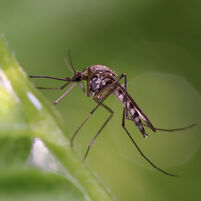Non-foodborne zoonotic diseases

Zoonotic diseases are infections or diseases that can be transmitted between animals and humans. As these diseases can cause sickness or death, EFSA tracks and reports them.

Several zoonotic diseases in humans – such as salmonellosis and listeriosis – are caused by eating contaminated food or drinking water. Other zoonotic diseases are transmitted to humans in other ways:
Vectorborne, e.g being bitten by a tick, a mosquito, a flea. Diseases that can be transmitted in this way include malaria, West Nile virus and Lyme disease.
Direct contact or close proximity. Coming into contact with the saliva, blood, urine, mucous, faeces or other body fluids of an infected animal; or with areas where animals live and roam, or objects or surfaces that have been contaminated with germs.
Diseases that are mainly transmissible to other animals or humans in this way include:
- Avian influenza, a highly contagious viral disease which occurs primarily in poultry and wild water birds.
- Q fever, a disease caused by the bacterium Coxiela burnetti. It has been reported in a wide range of species, including cattle, sheep and goats. People can get infected by breathing in dust contaminated with bacteria from the placenta and birth fluids or faeces of infected animals.
- A strain of the bacterium Meticillin-resistant Staphylococcus aureus (CC398) which can be transmitted through contact with live animals.
- Salmonella infections, which can originate from contact with infected reptiles and amphibians such as pet snakes, iguanas and frogs or their environment.
- Verotoxin-producing Escherichia coli (E. coli),which can be acquired through contact with infected farm animals.
These diseases can also be transmitted through the environment, e.g. Verotoxin-producing E. coli in contaminated swimming water.
EFSA's role
EFSA’s main role is to assess risks associated with the EU food chain, ensuring a high level of consumer protection and animal health. EFSA’s independent scientific advice and scientific assistance on the food safety and animal health-related aspects of zoonotic diseases supported by data collected in Member States helps European decision-makers to set policies and make decisions to protect consumers in the European Union.
EFSA provides independent scientific advice through:
- collecting and analysing data which enables the monitoring of risks in collaboration with ECDC on zoonotic microorganisms in human and animal populations and in food and feed as well as data on food-borne outbreaks;
- assessing the risks throughout the food chain for human health and also the risks for animal healthand making recommendations on the prevention and reduction of food-borne zoonoses.
EFSA analyses monitoring data on zoonoses, zoonotic microorganisms, antimicrobial resistance, microbiological contaminants and food-borne outbreaks across the EU. Learn more about how EFSA monitors and analyses foodborne diseases.
EFSA provides scientific advice on animal health-related aspects of non-food-borne zoonotic diseases and in some cases on the possible impact on public health. For example, experts assessed the risks posed by avian influenza and Q fever, and provided advice on possible control and mitigation options.
EU framework
The monitoring and control of zoonotic diseases is regulated by EU legislation on zoonoses and communicable diseases.
The EU has set up systems for collecting and analysing data from Member States on the prevalence of zoonotic agents in humans and animal populations. The data provides a basis for developing control measures to prevent and reduce the prevalence of these micro-organisms in animal populations.
According to EU legislation, many communicable diseases, such as Q fever, have to be notified by Member States to either national authorities or the European Commission. They are managed by various control, eradication and prevention measures.
The EU has also set out specific rules on the surveillance, control and eradication measures to be taken in the event of an avian influenza outbreak.
- Zoonoses monitoring in the EU – European Commission
- EU measures on animal diseases – European Commission
- Avian influenza – European Commission